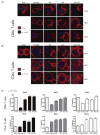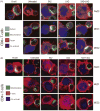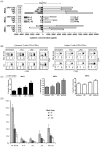Restoring the functional immunogenicity of chronic lymphocytic leukemia using epigenetic modifiers
- PMID: 20863567
- PMCID: PMC4458853
- DOI: 10.1016/j.leukres.2010.08.001
Restoring the functional immunogenicity of chronic lymphocytic leukemia using epigenetic modifiers
Abstract
Chronic lymphocytic leukemia (CLL) is a malignancy arising from immune cells (B-lymphocytes) endowed with intrinsic antigen-presenting capabilities. Such a function however is lost during malignant transformation and CLL cells are well known for their inability to process and present antigens to the T-cell arm of the immune system. Instead, malignant CLL cells elicit a vast array of immune regulatory mechanisms conducive to T-cell dysfunction and immunosuppression. Previously, we have shown that treatment of CLL cells with the demethylating agent 5-aza-2'-deoxycytidine unleashed target antigen expression. Here we show for the first time that combining two epigenetic modifiers, 5-aza-2'-deoxycytidine and the histone deacetylase inhibitor LAQ824 effectively restores the immunogenicity of CLL cell lines as well as primary cells obtained from CLL patients. Indeed, such a combination induces the expression of novel and highly antigenic cancer-testis antigens (CTAs) and costimulatory molecules. These changes facilitate the formation of robust supramolecular activation complexes (SMAC) between CLL cells and responder T-cells leading to intracellular signaling, lytic granule mobilization, and polarization of functional and relevant T-cell responses. This cascade of T-cell activating events triggered by CLL cells with restored APC function, points to combined epigenetic modifier treatment as a potential immunotherapeutic strategy for CLL patients.
Copyright © 2010 Elsevier Ltd. All rights reserved.
Figures
Similar articles
-
Epigenetic repolarization of T lymphocytes from chronic lymphocytic leukemia patients using 5-aza-2'-deoxycytidine.Leuk Res. 2011 Sep;35(9):1193-9. doi: 10.1016/j.leukres.2011.02.007. Epub 2011 Mar 5. Leuk Res. 2011. PMID: 21377729 Free PMC article.
-
Treatment of chronic lymphocytic leukemia with a hypomethylating agent induces expression of NXF2, an immunogenic cancer testis antigen.Clin Cancer Res. 2009 May 15;15(10):3406-15. doi: 10.1158/1078-0432.CCR-08-2099. Epub 2009 Apr 28. Clin Cancer Res. 2009. PMID: 19401350
-
Preclinical evaluation of antineoplastic activity of inhibitors of DNA methylation (5-aza-2'-deoxycytidine) and histone deacetylation (trichostatin A, depsipeptide) in combination against myeloid leukemic cells.Leuk Res. 2003 May;27(5):437-44. doi: 10.1016/s0145-2126(02)00222-9. Leuk Res. 2003. PMID: 12620295
-
T Cells in Chronic Lymphocytic Leukemia: A Two-Edged Sword.Front Immunol. 2021 Jan 20;11:612244. doi: 10.3389/fimmu.2020.612244. eCollection 2020. Front Immunol. 2021. PMID: 33552073 Free PMC article. Review.
-
Abnormal T-cell function in B-cell chronic lymphocytic leukaemia.Leuk Lymphoma. 2003 Mar;44(3):383-9. doi: 10.1080/1042819021000029993. Leuk Lymphoma. 2003. PMID: 12688308 Review.
Cited by
-
Silencing of HDAC6 as a therapeutic target in chronic lymphocytic leukemia.Blood Adv. 2018 Nov 13;2(21):3012-3024. doi: 10.1182/bloodadvances.2018020065. Blood Adv. 2018. PMID: 30425065 Free PMC article.
-
Molecular basis of chronic lymphocytic leukemia diagnosis and prognosis.Cell Oncol (Dordr). 2015 Apr;38(2):93-109. doi: 10.1007/s13402-014-0215-3. Epub 2015 Jan 7. Cell Oncol (Dordr). 2015. PMID: 25563586 Review.
-
Histone acetyltransferases and histone deacetylases in B- and T-cell development, physiology and malignancy.Genes Cancer. 2015 May;6(5-6):184-213. doi: 10.18632/genesandcancer.65. Genes Cancer. 2015. PMID: 26124919 Free PMC article. Review.
-
Epigenetic Modifiers: Anti-Neoplastic Drugs With Immunomodulating Potential.Front Immunol. 2021 Mar 30;12:652160. doi: 10.3389/fimmu.2021.652160. eCollection 2021. Front Immunol. 2021. PMID: 33859645 Free PMC article. Review.
-
Therapeutic implications of activation of the host gene (Dleu2) promoter for miR-15a/16-1 in chronic lymphocytic leukemia.Oncogene. 2014 Jun 19;33(25):3307-15. doi: 10.1038/onc.2013.291. Epub 2013 Sep 2. Oncogene. 2014. PMID: 23995789 Free PMC article.
References
-
- Jemal A, Siegel R, Ward E, et al. Cancer statistics, 2008. CA Cancer J Clin. 2008;58(2):71–96. - PubMed
-
- Krackhardt AM, Witzens M, Harig S, et al. Identification of tumor-associated antigens in chronic lymphocytic leukemia by SEREX. Blood. 2002;100(6):2123–31. - PubMed
-
- Ouillette P, Erba H, Kujawski L, et al. Integrated genomic profiling of chronic lymphocytic leukemia identifies subtypes of deletion 13q14. Cancer Res. 2008;68(4):1012–21. - PubMed
-
- Kay NE, Rai KR, O’Brien S. Chronic lymphocytic leukemia: current and emerging treatment approaches. Clin Adv Hematol Oncol. 2006;4(11 Suppl 22):1–10. quiz 11–2. - PubMed
Publication types
MeSH terms
Substances
Grants and funding
LinkOut - more resources
Full Text Sources
Other Literature Sources







